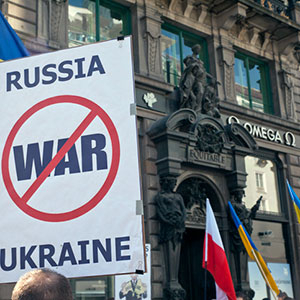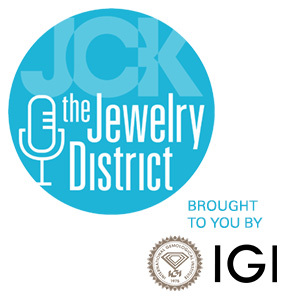
It’s clear: Stronger sanctions on Russian diamonds are coming—probably after the new year.
At the recent JCK show in Las Vegas, Brad Brooks-Rubin, special adviser on sanctions to the U.S. State Department (and a veteran of the Responsible Jewellery Council and GIA), and Skander Nasra, diplomatic adviser to the prime minister of Belgium, met with diamond industry members and groups to discuss ratcheting up restrictions on Russian diamonds. (Current U.S. rules allow the import of Russian-mined gems if polished elsewhere.)
While a lot is up in the air, sources who have talked with government officials expect the following:
– All G7 and European Union countries will prohibit the import of gems mined in Russia, even if cut and polished overseas.
– The new rules will likely kick in Jan. 1, 2024. While the industry is happy the sanctions won’t interfere with the holiday season, it’s nervous the effective date is only six months away.
– At first, the regulations may be limited to diamonds 1 ct. and larger. The minimum weight could progressively decrease as time goes on, possibly at six-month intervals.
– Customs will require importers to declare their diamonds aren’t from Russia, but will not ask for other info about the diamond’s origin.
The biggest unknown is what documentation—if any—importers will need to back up declarations of non-Russia origin. Most hope Customs will accept paperwork from any of the current industry tracking systems—such as Sarine’s Diamond Journey, De Beers’ Tracr, Everledger, and the U.S. Jewelry Council’s Diamond Source Warranty Protocol. A Kimberley Process certificate might suffice, provided it shows non-Russian origin and can be traced back to the original rough.
Questions remain about how artisanal miners and “cottage” cutters in India will participate in this new system, as they often lack access to tech-based tools, and about “grandfathered” goods that might have no provenance or were purchased from Russia prior its invasion of Ukraine. And, while this may not be an industry concern, checking every diamond import could place a heavy burden on Customs agents, who already have plenty of responsibility.
“We are hearing a lot of anxiety about the practical steps needed,” says Tiffany Stevens, president, CEO, and general counsel of Jewelers Vigilance Committee. “This is a complex issue. The State Department is taking this step-by-step because they want to do this right. There will be multiple pathways, some of which already exist, hopefully for a pretty wide scope of the industry.”
To date, the industry has not exactly provided a united front. American groups and companies—particularly bigger names that already have sourcing protocols in place—say they support the government’s aims. Antwerp initially opposed all sanctions, arguing the goods would just go to Dubai; it now insists that only a “science-based” origin solution (like Spacecode) would work. But most consider such technology a long shot, and lately the Belgian government has indicated it will move forward with sanctions, whether Antwerp likes it or not.
In India and the United Arab Emirates—two countries that have yet to condemn the Russian invasion—transactions with Russian miner Alrosa remain legal. That’s not likely to change anytime soon, and Indian officials have made dire predictions about possible job losses for cutters if the market for Russian rough dries up. (In January, India’s KGK set up a factory in Russia’s neighbor Armenia, possibly in an attempt to secure supply.) Dubai, eager to shed its image as a haven for Russian oligarchs, has said it’s open to segregating Russian goods.
With D-day approaching, World Diamond Council president Feriel Zerouki says the trade needs to unite behind a single proposal. “We hope to get the entire industry together so we can find a solution that’s practical and implementable,” says Zerouki, who is also De Beers’ senior vice president for corporate affairs. The sometimes fractious WDC is “nearly 100% there,” she adds.
Assuming a new framework is agreed to, all the G7 nations, as well as members of the European Union, will have to change their policies, since none currently bans Russian polished. In the United States, this will likely require either new legislation or a modification of the existing executive order banning Russian diamonds.
With all this lurking in the background, both De Beers and Rapaport Corp. announced new or expanded provenance programs at the JCK show.
De Beers has opened its Tracr platform, which uses blockchain to map a diamond’s origin, to the entire industry. GIA, e-tailer Brilliant Earth, and grading lab GSI have already signed up.
Tracr had been in development for years, but “the invasion of Ukraine changed everything,” says De Beers chief brand officer David Prager. “What was once an interesting project for De Beers all of a sudden became essential for the industry. We have really worked to drive Tracr’s scalability.”
He says Tracr is not just about mitigating risk, “but is a real opportunity to connect people with their diamond source.”
Tracr will only carry goods from Responsible Jewellery Council (RJC)–certified mines. That excludes Russian miner Alrosa, which left RJC in 2022. De Beers sees it as akin to an iPhone, a platform on which other apps, including its new Origin suite of services, can be built.
Rapaport announced that diamonds sourced from Botswana’s Okavango Diamond Company that have GIA diamond origin reports will receive a Green Star designation on the RapNet listing service. The company also is asking people to not list Russian diamonds on RapNet.
Clearly, the diamond industry is about to undergo a major change. In 2000, when the trade agreed to form the Kimberley Process, it made a conscious decision to separate diamonds into two streams: non-conflict (inside the KP) and conflict (outside).
Now, in addition to embracing tracking and tracing, the diamond world seems to be moving toward two more streams: one without Russian diamonds (inside the G7) and one with (everywhere else).
Of course, no system will be perfect, and the G7 doesn’t have the same reach as the Kimberley Process—which encompasses almost every diamond center or producer on Earth. Yet the United States remains the biggest market, so the trade will have a hard time ignoring what’s going on.
“If I were a commercial actor,” says Stevens. “I would be developing a hard wall between Russian and non-Russian goods. Because this is coming.”
(Credit: iStock/benstevens)
- Subscribe to the JCK News Daily
- Subscribe to the JCK Special Report
- Follow JCK on Instagram: @jckmagazine
- Follow JCK on X: @jckmagazine
- Follow JCK on Facebook: @jckmagazine





